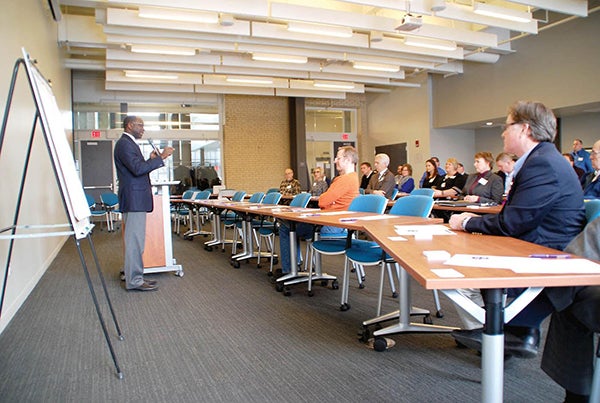Business, education leaders discuss workforce needs in Owatonna
Published 1:04 pm Sunday, January 24, 2016

Riverland Community College president Dr. Adenuga Atewologun speaks during a summit to discuss meeting Minnesota’s workforce needs Friday in Owatonna. Photo by the Owatonna’s People’s Press
By William Morris
Owatonna Peoples Press
OWATONNA — Meeting Minnesota’s workforce needs will require businesses, governments and educators, but only if they’re able to listen to each other.
That was the main theme Friday at Owatonna Public Utilities that brought two university presidents — Richard Davenport of Minnesota State University, Mankato, and Adenuga Atewologun of Riverland Community College — together with local government officials and leaders from numerous local companies. Almost 40 people gathered to discuss areas in which businesses are struggling to find workers and ways to help meet those needs.
The event was organized by Owatonna Partners for Economic Development in cooperation with MSU. MSU president Davenport said the university hopes to come away with ideas for specific programming options to help support local businesses.
“We’re here to listen, to hear, what are the areas where we can be the most helpful,” he said. “We’re looking at bringing a different menu to the area where we think we can be very helpful working with the existing entities right here in Owatonna.”
Atewologun said colleges and universities rely on local needs to help set their curriculum.
“The programs we will offer will depend on you,” he said. “I don’t offer textile technology. I offer nursing and radiology because those are relevant to our region. … We want to make sure we are relevant to you, but we don’t always listen. We have to do more listening.”
And lots of listening they did. Attendees included Dr. Brian Bunkers of Mayo Clinic, who asked about shortages of nursing candidates, and Dale Gandrud of Gandy Company, who said skilled workers to operate expensive machine tools were in short supply.
Addressing nursing, Atewologun said the shortage includes not just nursing students, but teachers.
“I believe we have a shortage of getting students into the program because we’re also looking for committed nursing educators, so I hope we can use some of your experienced nurses to teach classes because we don’t get enough educators,” he said.
Davenport said his university also was looking at ways to remove bottlenecks in nursing training.
“The nursing programs at MSU are full. This year we had 200 applicants for 60 spots,” he said. “We’re looking at Minnesota State at how to pilot that, how to enable us to take more students into the program.”
Over lunch, the attendees broke into several working groups to discuss industry-specific needs before rejoining to discuss takeaways from the day’s discussions.
“We’re not going to just do things as usual,” said Davenport, who said MSU will look at opening a new strategic partnership center in the Owatonna area. “If we can’t fill a class with 30 students, let’s not worry about that. Let’s focus on working with Owatonna and other areas. … These kind of sessions I think could lead toward addressing the workforce needs we have down here.”
The last word went to Owatonna Area Chamber of Commerce and Tourism President Jennifer Libby.
“I think we can all agree we need to do things differently than we have in the past,” she said. “We never want to be arrogant and assume we know what you want. We’ve had lots of conversations, but the best way is always to get people in the same room together.”
William Morris is a reporter for the Owatonna People’s Press. He can be reached at 444-2372; follow him on Twitter @OPPWilliam

